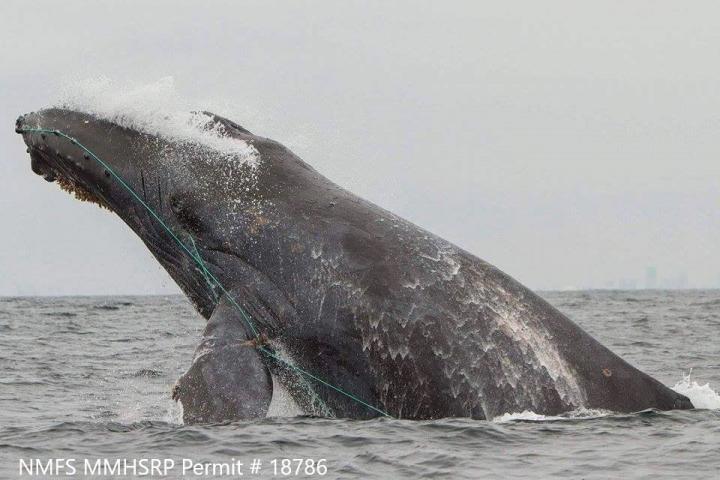Entanglements of humpback whales in fishing gear along the US West Coast increased dramatically during the 2014 to 2016 marine heat wave known as the ‘warm blob’

Credit: NOAA-NMFS West Coast Region
Climate change is increasing the frequency and severity of marine heat waves–warm water anomalies that disrupt marine ecosystems–and this is creating new challenges for fisheries management and ocean conservation. A new study shows how the record-breaking marine heat wave of 2014 to 2016 caused changes along the U.S. West Coast that led to an unprecedented spike in the numbers of whales that became entangled in fishing gear.
“With the ocean warming, we saw a shift in the ecosystem and in the feeding behavior of humpback whales that led to a greater overlap between whales and crab fishing gear,” said Jarrod Santora, a researcher in applied mathematics at UC Santa Cruz and first author of the study, published January 27 in Nature Communications.
Santora, who is also affiliated with the NOAA Southwest Fisheries Science Center, uses data-driven models of marine ecosystems to inform fishery management and conservation. As science advisor for a working group convened to address the whale entanglement problem, he has been providing his analyses to state and federal agencies to help them make management decisions that can reduce the risk of entanglement.
“It was a perfect storm of events over those three years, but we now have the ability to prevent that from happening again,” Santora said. “We’ve developed a risk assessment and mitigation program, we’re doing aerial surveys, and we’re providing ecosystem-based indicators to the state resource managers so they can make informed decisions. There’s a huge team of people working on this.”
The high productivity of the California Current is supported by wind-driven upwelling of cool, nutrient-rich water along the coast, which sustains large populations of prey (such as krill, anchovy, and sardines) that attract whales and other predators. The intensity of upwelling and the extent of cool enriched water off the coast varies from year to year, but the extreme warming event in 2014-16 (which became known as the “warm blob”) compressed this prime habitat into a very narrow band along the coast, Santora explained.
“Predators that are normally more spread out offshore all moved inshore because that’s where the food was,” he said. “Krill populations always take a hit during warming events, but we started to see an increase in anchovy. Humpback whales are unique in their ability to switch between krill and small fish, so during those years they moved inshore after the anchovy.”
That shift brought an unusual number of whales into areas where they were more likely to encounter crab fishing gear. Whale entanglements, which averaged about 10 per year prior to 2014, shot up to 53 confirmed entanglements in 2015 and remained high at 55 confirmed entanglements in 2016.
Further complicating the situation was another consequence of the marine heat wave, an unprecedented bloom of toxic algae along the West Coast. When scientists detected dangerous levels of the neurotoxin domoic acid in Dungeness crabs, the opening of the 2015-16 crab fishing season was delayed until late March 2016. Normally, crab fishing activity is highest in November and December, but in 2016, peak fishing activity coincided with the arrival of migrating whales off California in April and May.
“All this gear was going out right during the peak arrival of whales, so that made things worse,” Santora said. “But 2016 is not the whole story. We started to see an increase in whale entanglements in late 2014, well before the delayed crab season, and that was due to the habitat compression along the coast.”
Another factor, he said, is the ongoing recovery of whale populations. Conservation efforts that began in the 1960s have enabled many populations that were decimated by commercial whaling to begin making a comeback. Although some North Pacific humpback whale populations are still considered threatened or endangered, their overall numbers have been increasing.
According to Santora, the events of 2014-16 show how important it is for scientists to work closely and communicate clearly with fisheries managers and other stakeholders. One positive outcome of the entanglement crisis was the creation of the California Dungeness Crab Fishing Gear Working Group, which includes commercial fishermen, state and federal resource managers, conservationists, and scientists. The group has developed a Risk Assessment and Mitigation Program to support collaborative efforts to reduce entanglements.
“Nobody wants to entangle whales,” Santora said. “People are working to develop ropeless gear, but broad application of that new technology is still far in the future. For now, the best we can do is to monitor the situation closely and get ecosystem science information to the people who need it.”
###
In addition to Santora, the coauthors of the paper included NOAA Fisheries researchers Nathan Mantua, Isaac Schroeder, John Field, Elliott Hazen, Steven Bograd, Brian Wells, Lauren Saez, Dan Lawson, and Karen Forney; William Sydeman at the Farallon Institute; and John Calambokidis at the Cascadia Research Collective. This work was supported in part by the California Ocean Protection Council and by the U.S. Marine Biodiversity Observation Network, jointly funded by NOAA, NASA, and the National Oceanographic Partnership Program.
Media Contact
Tim Stephens
[email protected]
831-459-4352
Related Journal Article
http://dx.




